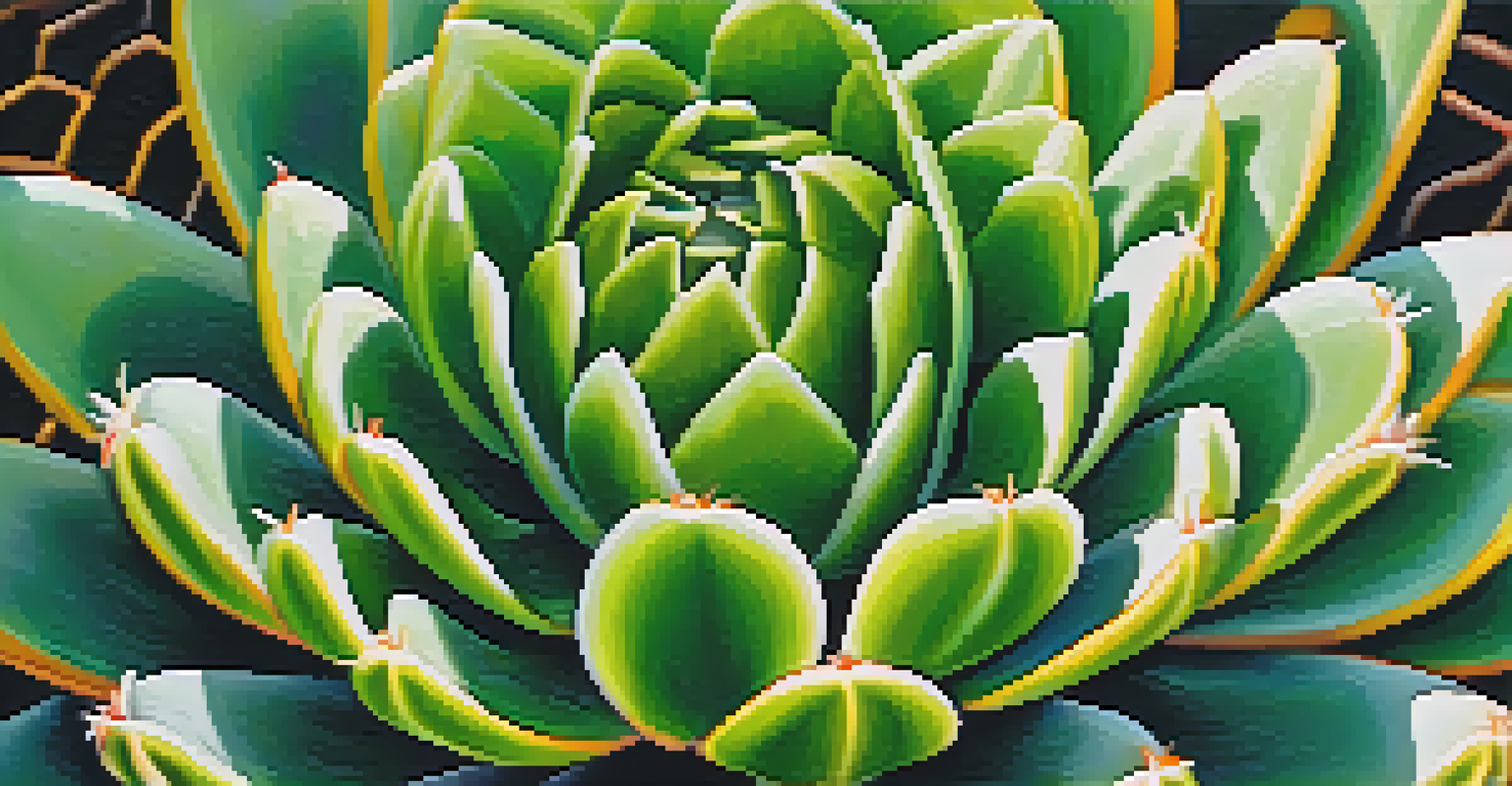The Role of Peyote in Indigenous Community Relationships

Introduction to Peyote and Indigenous Cultures
Peyote, a small cactus native to North America, holds profound significance in various Indigenous cultures. Traditionally, it has been used in spiritual ceremonies and healing practices, showcasing its deep-rooted connection to the identities of these communities. Understanding this cultural context is essential to appreciating how peyote influences relationships and social structures.
The land is where our roots are. The children must be taught to feel and live in harmony with the Earth.
For many Indigenous peoples, peyote is more than just a plant; it's a symbol of resilience and continuity. Its use in rituals fosters a sense of unity among community members, creating shared experiences that strengthen bonds. As we delve deeper, it's crucial to recognize the multifaceted roles peyote plays in these communal interactions.
Throughout history, peyote has served as a vehicle for cultural expression and spiritual exploration, reinforcing the values and beliefs of Indigenous communities. This connection emphasizes the importance of preserving these traditions in the face of modern challenges, ensuring that the significance of peyote endures.
Peyote in Spiritual and Ceremonial Practices
One of the most prominent uses of peyote is in spiritual and ceremonial contexts, where it plays a pivotal role in rituals. During ceremonies, participants consume the cactus to facilitate visions and promote introspection, leading to a deeper understanding of their spiritual journeys. This shared experience creates a profound sense of community and belonging among participants.

These rituals often involve songs, prayers, and storytelling, all of which are integral to the cultural heritage of Indigenous peoples. By engaging in these practices, communities reinforce their shared history and values, fostering a collective identity. The act of gathering to partake in peyote ceremonies not only strengthens individual relationships but also fortifies the community as a whole.
Peyote: A Cultural Centerpiece
Peyote serves as a vital cultural touchstone for Indigenous communities, reinforcing identities and fostering unity through shared rituals.
Moreover, the psychological benefits of these ceremonies can lead to personal healing and growth, further enhancing the interconnectedness among participants. As individuals share their experiences, they contribute to a rich tapestry of collective wisdom, which is vital for sustaining cultural traditions.
Peyote and Community Healing Practices
In addition to its spiritual significance, peyote is often utilized in healing practices within Indigenous communities. It is believed to possess therapeutic properties that can aid in the treatment of various physical and mental ailments. By incorporating peyote into healing rituals, community members come together in support of one another, reinforcing social ties.
Indigenous peoples have a deep connection to their land and culture, and their traditions are vital for the preservation of biodiversity and cultural heritage.
The healing process is not just an individual journey; it is a communal effort that fosters empathy and understanding among participants. As individuals share their struggles and triumphs, the bonds between them deepen, promoting a culture of support and resilience. This interconnectedness is crucial for the overall well-being of the community.
Moreover, these healing practices help to preserve Indigenous knowledge and traditions, ensuring that future generations inherit a rich cultural legacy. By prioritizing communal healing, Indigenous peoples can navigate the challenges posed by modernity while remaining rooted in their ancestral practices.
The Role of Peyote in Identity Formation
Peyote plays a significant role in shaping Indigenous identities, serving as a cultural touchstone that connects individuals to their heritage. For many, participation in peyote ceremonies is a way to affirm their cultural identity and solidarity with their community. This connection is especially important in a world where Indigenous identities are often marginalized or overlooked.
The act of consuming peyote within a ceremonial context reinforces a sense of belonging and pride among community members. It acts as a reminder of their shared history and the struggles they have endured, creating a bond that transcends generations. This shared identity fosters resilience in the face of external challenges.
Community Healing Through Peyote
The use of peyote in healing practices strengthens social ties and promotes empathy among community members, enhancing overall well-being.
Furthermore, as communities navigate the complexities of modern life, peyote serves as a reminder of their cultural roots. This ongoing relationship with peyote not only strengthens individual identities but also reinforces the collective identity of Indigenous peoples, ensuring that their traditions and values continue to thrive.
Intergenerational Transmission of Peyote Traditions
The traditions surrounding peyote are often passed down through generations, creating a rich lineage of knowledge and practice within Indigenous communities. Elders play a crucial role in this transmission, imparting wisdom and teachings that connect younger members to their cultural heritage. This intergenerational exchange is vital for preserving the significance of peyote.
By participating in peyote ceremonies, younger generations learn not only about the plant itself but also about their community's values, history, and spirituality. This engagement fosters a sense of responsibility to carry forward these traditions, ensuring that they remain vibrant and relevant. It's a beautiful cycle of learning and growth that strengthens community ties.
Moreover, this transmission of knowledge encourages pride in cultural identity and a deeper understanding of one's place within the community. As younger members embrace these traditions, they contribute to the ongoing evolution of peyote practices, ensuring that they adapt while remaining rooted in their origins.
Challenges Facing Peyote Practices Today
Despite its significance, the practice of using peyote faces numerous challenges in contemporary society. Legal restrictions and the increasing commercialization of peyote have put pressure on Indigenous communities, threatening their traditional practices. This situation raises concerns about cultural appropriation and the dilution of sacred rituals.
Moreover, climate change and habitat loss pose additional threats to the natural peyote populations, making it more difficult for communities to access this vital resource. As the availability of peyote declines, so too does the opportunity for communities to engage in the rituals that connect them to their heritage. This underscores the urgency of protecting both the plant and the cultural practices surrounding it.
Challenges to Peyote Practices
Indigenous communities face significant challenges, including legal restrictions and climate change, which threaten the availability and practice of peyote traditions.
In response to these challenges, many Indigenous communities are advocating for the preservation of their peyote traditions and the protection of their rights. By raising awareness and educating the public about the importance of peyote, they aim to ensure that future generations can continue to benefit from this powerful plant and its role in fostering community relationships.
The Future of Peyote in Indigenous Communities
Looking ahead, the future of peyote in Indigenous communities will depend on a combination of cultural resilience and advocacy. As communities continue to navigate modern pressures, they must also find ways to honor and preserve their traditions. By fostering dialogue and collaboration, they can work towards safeguarding the role of peyote in their cultural practices.
Education and awareness will play a crucial role in this endeavor. By sharing their stories and experiences, Indigenous peoples can help others understand the significance of peyote and the importance of protecting their rights. This not only benefits Indigenous communities but also enriches the wider society by promoting cultural diversity and understanding.

Ultimately, the future of peyote is intertwined with the future of Indigenous identities and communities. By nurturing these connections, we can ensure that the rich traditions surrounding peyote continue to thrive, fostering relationships that are rooted in respect, understanding, and love.